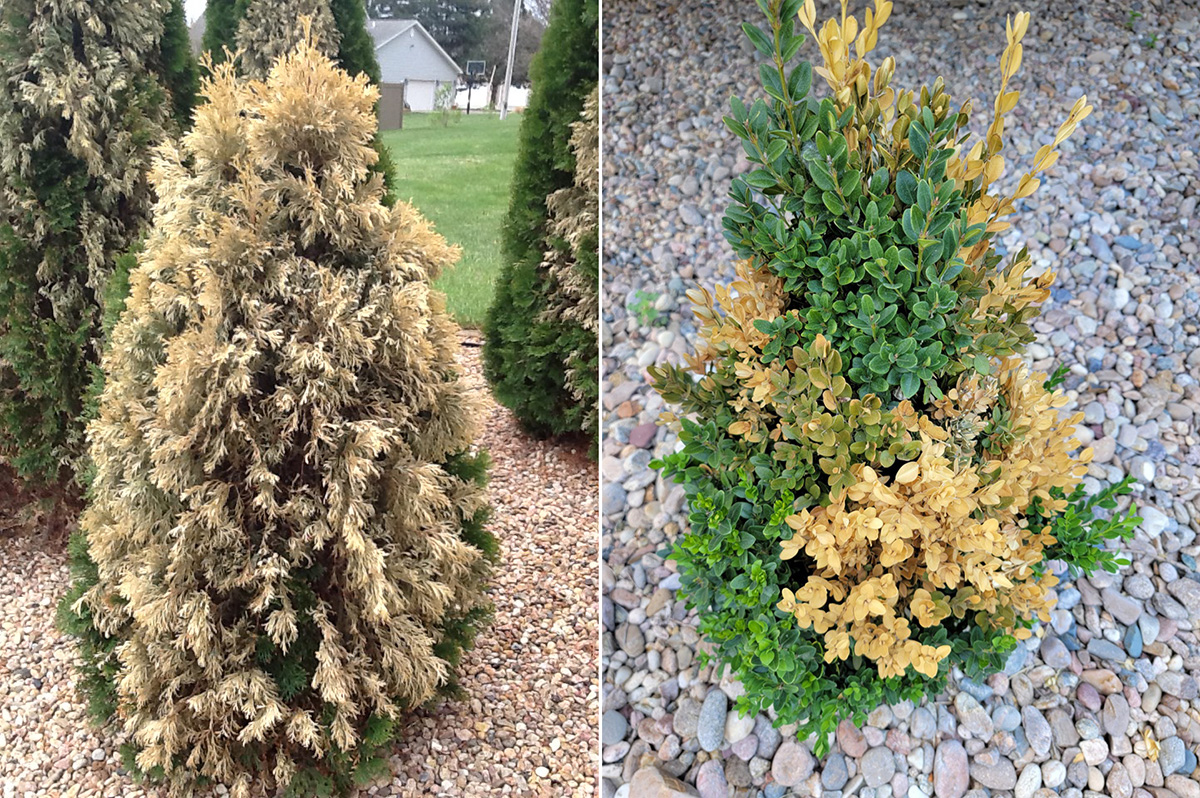
By Sarah Browning, Extension Educator in Lancaster County
In fall, warm, dry days with cool nights usually lead to great fall leaf coloration, but dry, late summer and fall conditions have a downside, too. Trees and shrubs not fully hydrated going into winter are prone to winter desiccation, a common injury occurring when the amount of water lost by plants exceeds the amount picked up by the roots.
WINTER DAMAGE IN RECENT YEARS
In the last two springs, many homeowners have found dead, brown foliage on their evergreen plants, particularly arborvitae, boxwood and evergreen hollies. In spring 2022, we also saw damage or death on spruce, juniper and yew. The extent of winter damage symptoms varied from brown needle tips on one side of the plant, to one or two dead branches, to entire dead trees — some well-established trees that had been planted for several years where damage from dry winter conditions would not be expected. Injury may be found on the outer portion of the branches, but it is often most severe on the side of the tree facing the wind or a source of radiated heat, such as a south- or west-facing brick wall or street.
Young or newly planted trees and shrubs are most susceptible to drought injury, because they have not yet established the extensive root system needed to draw moisture from the soil during dry conditions.
Plant damage from winter desiccation is often preventable. Since Nebraska frequently experiences dry fall and early winter conditions, deep-watering plants in fall may mean the difference between healthy, vigorous trees and shrubs, or stressed, struggling trees next spring.
Although Lancaster County is experiencing normal precipitation this fall, according to the U.S. Drought Monitor, https://droughtmonitor.unl.edu/, deep-watering your trees and shrubs until the ground freezes, unless we receive 1-inch of rain per week, will improve plant health next year.
Want to learn more about winter desiccation? Check out the following publications:
• “Preventing Winter Damage in Trees, Shrubs and Perennials,” https://go.unl.edu/pwdt
• “Winter Protection for Sensitive Plants,” https://go.unl.edu/wpsp
PREVENTING WINTER DESICCATION
Begin by applying a 3-6 foot diameter ring of mulch around the base of trees and shrubs, with 3-4 inches of an organic material. Keep the mulch in a flat layer — like a pancake — not piled up against the tree’s bark. Pull the mulch back 1-2 inches from the tree’s bark. Use any type of organic mulch, like coarse shredded hardwood or wood chips, and don’t apply landscape fabric beneath the mulch. Lay it right on top of the ground.
During fall, plants should receive 1-inch of water per week, either through irrigation or rain, to enable them to fully rehydrate following summer's dry conditions. If rain doesn't come, plan to water trees. A deep soaking every two weeks is adequate for most trees in unirrigated landscapes. Apply water deeply, moistening the soil to a depth of about 12-18 inches, until the ground freezes. Use a long-bladed screwdriver or piece of rebar to check the depth of water penetration. Once you’ve reached dry soil, it will be much harder to push the probe into the ground.
If using a sprinkler, let it run in a low pattern in one area until the top 12-18 inches of soil is moistened, then move it as needed to water the entire area underneath the tree’s canopy; or, coil a soaker hose several times around the tree from the trunk to the dripline, and let it run until the soil is moistened.
A watering basin 2-3 inches deep and 3-4 feet in diameter, constructed around the base of young trees will hold water until it can percolate into the soil.
Plants repeatedly affected by winter desiccation should be evaluated for underlying problems, which make them susceptible to winter injury or relocated to a more protected location. Avoid repeated use of anti-desiccant products, like Wilt-Pruf, which interfere with plant photosynthesis.